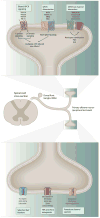Breaking barriers to novel analgesic drug development
- PMID: 28596533
- PMCID: PMC5675565
- DOI: 10.1038/nrd.2017.87
Breaking barriers to novel analgesic drug development
Erratum in
-
Breaking barriers to novel analgesic drug development.Nat Rev Drug Discov. 2017 Nov;16(11):810. doi: 10.1038/nrd.2017.202. Epub 2017 Oct 6. Nat Rev Drug Discov. 2017. PMID: 28983099 Free PMC article.
Abstract
Acute and chronic pain complaints, although common, are generally poorly served by existing therapies. This unmet clinical need reflects a failure to develop novel classes of analgesics with superior efficacy, diminished adverse effects and a lower abuse liability than those currently available. Reasons for this include the heterogeneity of clinical pain conditions, the complexity and diversity of underlying pathophysiological mechanisms, and the unreliability of some preclinical pain models. However, recent advances in our understanding of the neurobiology of pain are beginning to offer opportunities for developing novel therapeutic strategies and revisiting existing targets, including modulating ion channels, enzymes and G-protein-coupled receptors.
Figures



Similar articles
-
The transition from acute to chronic pain: understanding how different biological systems interact.Can J Anaesth. 2014 Feb;61(2):112-22. doi: 10.1007/s12630-013-0087-4. Epub 2013 Nov 26. Can J Anaesth. 2014. PMID: 24277113 Review.
-
Discovery and development of tramadol for the treatment of pain.Expert Opin Drug Discov. 2017 Dec;12(12):1281-1291. doi: 10.1080/17460441.2017.1377697. Epub 2017 Sep 17. Expert Opin Drug Discov. 2017. PMID: 28920461 Review.
-
The imidazoline receptors and ligands in pain modulation.Indian J Pharmacol. 2015 Sep-Oct;47(5):472-8. doi: 10.4103/0253-7613.165196. Indian J Pharmacol. 2015. PMID: 26600633 Free PMC article. Review.
-
Expert opinion on emerging drugs: chronic low back pain.Expert Opin Emerg Drugs. 2015 Mar;20(1):103-27. doi: 10.1517/14728214.2015.993379. Epub 2014 Dec 18. Expert Opin Emerg Drugs. 2015. PMID: 25519435 Review.
-
The evolving understanding of the analgesic mechanism of action of flupirtine.J Clin Pharm Ther. 2012 Feb;37(1):4-6. doi: 10.1111/j.1365-2710.2010.01233.x. Epub 2010 Nov 28. J Clin Pharm Ther. 2012. PMID: 21114508 Review.
Cited by
-
Effects of educational attainment on comorbidity of pain and depression in Chinese older adults.Heliyon. 2024 Sep 7;10(17):e37595. doi: 10.1016/j.heliyon.2024.e37595. eCollection 2024 Sep 15. Heliyon. 2024. PMID: 39290281 Free PMC article.
-
Glycine Receptor Subtypes and Their Roles in Nociception and Chronic Pain.Front Mol Neurosci. 2022 Mar 23;15:848642. doi: 10.3389/fnmol.2022.848642. eCollection 2022. Front Mol Neurosci. 2022. PMID: 35401105 Free PMC article. Review.
-
Profiling of fatty acid metabolism in the dorsal root ganglion after peripheral nerve injury.Front Pain Res (Lausanne). 2022 Jul 29;3:948689. doi: 10.3389/fpain.2022.948689. eCollection 2022. Front Pain Res (Lausanne). 2022. PMID: 35965594 Free PMC article.
-
A systematic review and meta-analysis of thigmotactic behaviour in the open field test in rodent models associated with persistent pain.PLoS One. 2023 Sep 8;18(9):e0290382. doi: 10.1371/journal.pone.0290382. eCollection 2023. PLoS One. 2023. PMID: 37682863 Free PMC article.
-
Central Neuropathic Mechanisms in Pain Signaling Pathways: Current Evidence and Recommendations.Adv Ther. 2020 May;37(5):1946-1959. doi: 10.1007/s12325-020-01334-w. Epub 2020 Apr 10. Adv Ther. 2020. PMID: 32291648 Free PMC article. Review.
References
-
- Dubois MY, Gallagher RM, Lippe PM. Pain medicine position paper. Pain Med. 2009;10:972–1000. - PubMed
-
- CDC. Opioid overdose deaths. Centers for Disease Control and Prevention; 2015.
-
- Decosterd I, Woolf CJ. Spared nerve injury: an animal model of persistent peripheral neuropathic pain. Pain. 2000;87:149–158. - PubMed
Publication types
MeSH terms
Substances
Grants and funding
LinkOut - more resources
Full Text Sources
Other Literature Sources
Medical
Molecular Biology Databases

